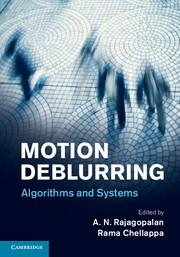Book contents
- Frontmatter
- Contents
- List of contributors
- Preface
- 1 Mathematical models and practical solvers for uniform motion deblurring
- 2 Spatially-varying image deblurring
- 3 Hybrid-imaging for motion deblurring
- 4 Efficient, blind, spatially-variant deblurring for shaken images
- 5 Removing camera shake in smartphones without hardware stabilization
- 6 Multi-sensor fusion for motion deblurring
- 7 Motion deblurring using fluttered shutter
- 8 Richardson–Lucy deblurring for scenes under a projective motion path
- 9 HDR imaging in the presence of motion blur
- 10 Compressive video sensing to tackle motion blur
- 11 Coded exposure motion deblurring for recognition
- 12 Direct recognition of motion-blurred faces
- 13 Performance limits for motion deblurring cameras
- Index
- References
3 - Hybrid-imaging for motion deblurring
Published online by Cambridge University Press: 05 June 2014
- Frontmatter
- Contents
- List of contributors
- Preface
- 1 Mathematical models and practical solvers for uniform motion deblurring
- 2 Spatially-varying image deblurring
- 3 Hybrid-imaging for motion deblurring
- 4 Efficient, blind, spatially-variant deblurring for shaken images
- 5 Removing camera shake in smartphones without hardware stabilization
- 6 Multi-sensor fusion for motion deblurring
- 7 Motion deblurring using fluttered shutter
- 8 Richardson–Lucy deblurring for scenes under a projective motion path
- 9 HDR imaging in the presence of motion blur
- 10 Compressive video sensing to tackle motion blur
- 11 Coded exposure motion deblurring for recognition
- 12 Direct recognition of motion-blurred faces
- 13 Performance limits for motion deblurring cameras
- Index
- References
Summary
Introduction
This chapter introduces a hybrid-imaging system for motion deblurring, which is an imaging system that couples two or more cameras that function differently to perform a unified task. The cameras are usually selected to have different specialized functions. For example, a hybrid stereo camera presented by Sawhney et al. (Sawhney, Guo, Hanna, Kumar, Adkins & Zhou 2001) utilizes two cameras with different spatial resolutions to obtain high resolution stereo output.
In the context of this chapter, a hybrid-imaging system refers to a standard high resolution camera, which we call the primary detector with an auxiliary low resolution camera called the secondary detector. The secondary detector shares a common optical path with the primary detector, but operates at a significantly higher frame rate.
The primary detector produces a high resolution, high quality colour image but is susceptible to motion blur, whereas the secondary detector output is a sequence of low resolution, often monochromatic and noisy images of the same scene taken during the exposure time of the primary detector. An example of the primary and secondary detectors' output is shown in Figure 3.1.
The image sequence produced by the secondary detector is of little visual use. However, it contains information about the motion of the camera during the exposure, or more precisely, the motion flow field of the image during integration time. While the camera motion and the observed flow field are not identical (e.g. the observed flow field includes information about moving objects in the scene as well as their depth), the idea of hybrid-imaging motion deblurring is that given the image sequence from the secondary detector, it would be possible to compute the blur function (or the PSF) at every point of the high resolution image taken by the primary detector.
- Type
- Chapter
- Information
- Motion DeblurringAlgorithms and Systems, pp. 57 - 74Publisher: Cambridge University PressPrint publication year: 2014



